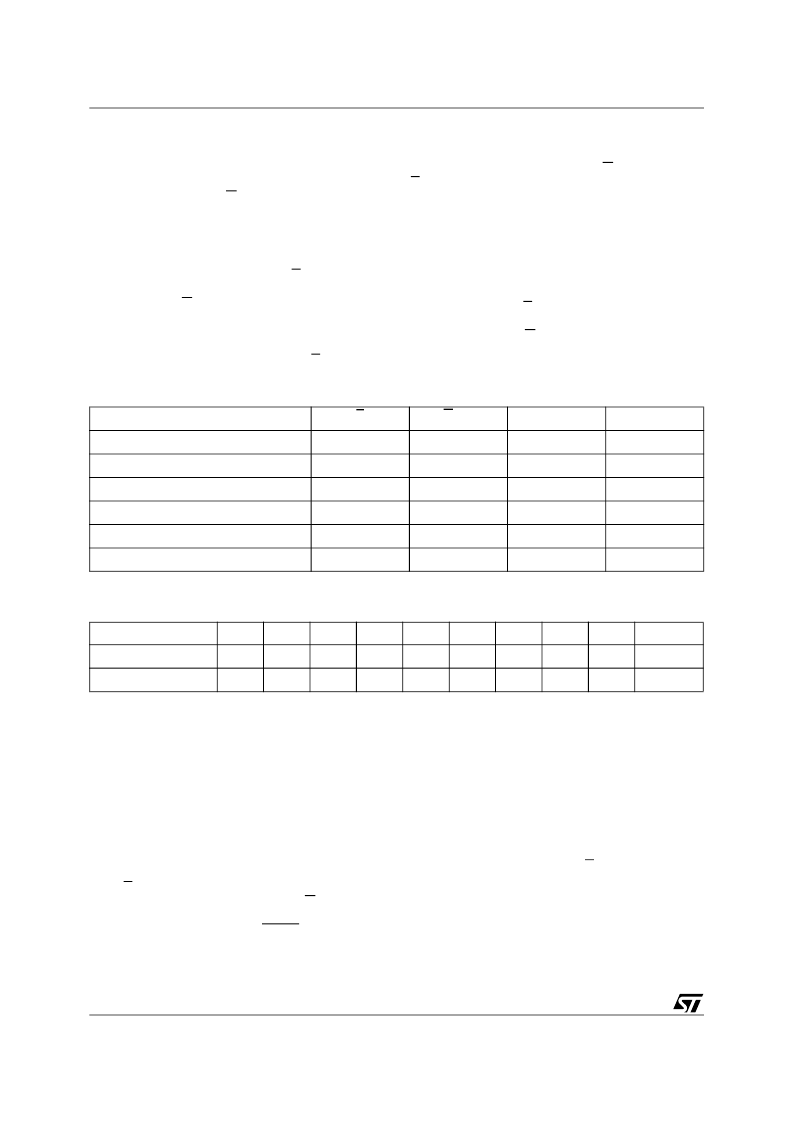- 您現(xiàn)在的位置:買賣IC網(wǎng) > PDF目錄359006 > M27W512-100N6 (意法半導(dǎo)體) 512 Kbit (64K x8) Low Voltage UV EPROM and OTP EPROM PDF資料下載
參數(shù)資料
| 型號(hào): | M27W512-100N6 |
| 廠商: | 意法半導(dǎo)體 |
| 英文描述: | 512 Kbit (64K x8) Low Voltage UV EPROM and OTP EPROM |
| 中文描述: | 512千位(64K的× 8)低壓紫外線EPROM和檢察官辦公室存儲(chǔ)器 |
| 文件頁數(shù): | 6/21頁 |
| 文件大?。?/td> | 369K |
| 代理商: | M27W512-100N6 |

M27W512
6/21
DEVICE OPERATION
The modes of operations of the M27W512 are list-
ed in the Operating Modes table. A single power
supply is required in the read mode. All inputs are
TTL levels except for GV
PP
and 12V on A9 for
Electronic Signature.
Read Mode
The M27W512 has two control functions, both of
which must be logically active in order to obtain
data at the outputs. Chip Enable (E) is the power
control and should be used for device selection.
Output Enable (G) is the output control and should
be used to gate data to the output pins, indepen-
dent of device selection. Assuming that the ad-
dresses are stable, the address access time
(t
AVQV
) is equal to the delay from E to output
(t
ELQV
). Data is available at the output after a delay
of t
GLQV
from the falling edge of G, assuming that
E has been low and the addresses have been sta-
ble for at least t
AVQV
-t
GLQV
.
Standby Mode
The M27W512 has a standby mode which reduc-
es the supply current from 15mA to 15μA with low
voltage operation V
CC
≤
3.6V, see Read Mode DC
Characteristics table for details. The M27W512 is
placed in the standby mode by applying a CMOS
high signal to the E input. When in the standby
mode, the outputs are in a high impedance state,
independent of the GV
PP
input.
Table 2. Operating Modes
Note: X = V
IH
or V
IL
, V
ID
= 12V ± 0.5V.
Table 3. Electronic Signature
Two Line Output Control
Because EPROMs are usually used in larger
memory arrays, the product features a 2 line con-
trol function which accommodates the use of mul-
tiple memory connection. The two line control
function allows:
a.
the lowest possible memory power
dissipation,
b.
complete assurance that output bus
contention will not occur.
For the most efficient use of these two control
lines, E should be decoded and used as the prima-
ry device selecting function, while G should be
made a common connection to all devices in the
array and connected to the READ line from the
system control bus. This ensures that all deselect-
ed memory devices are in their low power standby
mode and that the output pins are only active
when data is required from a particular memory
device.
System Considerations
The power switching characteristics of Advanced
CMOS EPROMs require careful decoupling of the
devices. The supply current, I
CC
, has three seg-
ments that are of interest to the system designer:
the standby current level, the active current level,
and transient current peaks that are produced by
the falling and rising edges of E. The magnitude of
the transient current peaks is dependent on the
capacitive and inductive loading of the device at
the output.
The associated transient voltage peaks can be
suppressed by complying with the two line output
control and by properly selected decoupling ca-
Mode
E
GV
PP
A9
Q7-Q0
Read
V
IL
V
IL
X
Data Out
Output Disable
V
IL
V
IH
X
Hi-Z
Program
V
IL
Pulse
V
PP
X
Data In
Program Inhibit
V
IH
V
PP
X
Hi-Z
Standby
V
IH
X
X
Hi-Z
Electronic Signature
V
IL
V
IL
V
ID
Codes
Identifier
A0
Q7
Q6
Q5
Q4
Q3
Q2
Q1
Q0
Hex Data
Manufacturer’s Code
V
IL
0
0
1
0
0
0
0
0
20h
Device Code
V
IH
0
0
1
1
1
1
0
1
3Dh
相關(guān)PDF資料 |
PDF描述 |
|---|---|
| M27W512-100N6E | 512 Kbit (64K x8) Low Voltage UV EPROM and OTP EPROM |
| M27W512-100N6F | 512 Kbit (64K x8) Low Voltage UV EPROM and OTP EPROM |
| M27W512-100N6TR | 512 Kbit 64Kb x8 Low Voltage UV EPROM and OTP EPROM |
| M27W512-120B6 | 512 Kbit (64K x8) Low Voltage UV EPROM and OTP EPROM |
| M27W512-120B6E | 512 Kbit (64K x8) Low Voltage UV EPROM and OTP EPROM |
相關(guān)代理商/技術(shù)參數(shù) |
參數(shù)描述 |
|---|---|
| M27W512-100N6E | 制造商:STMICROELECTRONICS 制造商全稱:STMicroelectronics 功能描述:512 Kbit (64K x8) Low Voltage UV EPROM and OTP EPROM |
| M27W512-100N6F | 制造商:STMICROELECTRONICS 制造商全稱:STMicroelectronics 功能描述:512 Kbit (64K x8) Low Voltage UV EPROM and OTP EPROM |
| M27W512-100N6TR | 制造商:STMICROELECTRONICS 制造商全稱:STMicroelectronics 功能描述:512 Kbit 64Kb x8 Low Voltage UV EPROM and OTP EPROM |
| M27W51210K6L | 制造商:STMicroelectronics 功能描述: |
| M27W512-120B6 | 制造商:STMICROELECTRONICS 制造商全稱:STMicroelectronics 功能描述:512 Kbit (64K x8) Low Voltage UV EPROM and OTP EPROM |
發(fā)布緊急采購,3分鐘左右您將得到回復(fù)。